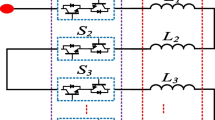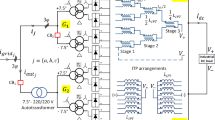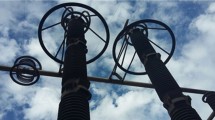Abstract
High-voltage and high-frequency stresses comprising of AC and DC components are encountered across the surge arresters at various nodes in HVDC stations. There is a need to generate these stresses to evaluate surge arresters employed at different locations in the HVDC networks. In the present work, an attempt is made to develop complex waveforms using a novel single-stage DC–AC converter. The presented switched-mode converter is based on a coupled inductor which gives an extra degree of freedom to obtain a higher gain with the modulation in the duty ratio. Fixing the turns ratio of the coupled inductor, the duty ratio is appropriately modulated to generate the complex waveform of high frequency and high amplitude. The proposed converter offers a single-stage solution for DC–AC inversion using pulse width modulation, with fewer components, higher power density, and the ability to generate a frequency of 600 Hz. The detailed converter and controller design analysis is discussed in the present investigation. The breakdown operation of the surge arrester demands a massive short-circuit current from the source side, which may be difficult to obtain if a high-gain amplifier is used without proper protection. The presented switched-mode converter-based approach rectifies the issue of the short-circuit current during the insulator breakdown. A simulation study is performed to validate the circuit for both positive and negative buck-boost regions. Further, a hardware setup is developed to verify the generation of high-frequency and high-voltage complex waveforms. The developed converter could be widely used for insulation evaluation and condition monitoring of various high-voltage equipment.


















Similar content being viewed by others
References
IEC: IEC 60099-9, Edition 1.0, Surge arresters-Part 9: metal-oxide surge arresters without gaps for HVDC converter stations. International electrotechnical commission, Geneva, Switzerland (2014)
IS: IS 15086 (Part 9), Surge arresters-Part 9: metal-oxide surge arresters without gaps for HVDC converter stations. Bureau of Indian Standards, New Delhi, India (2019)
Agrawal KC (2007) Electrical power engineering: reference & applications handbook. Suryodaya Publishers, Bangalore, India
ABB: High voltage surge arresters: buyer’s guide, webpage = https://library.e.abb.com/public/ba61a5f190bf46fe8676554e0a2e9e4a/Buyer’s%20Guide%20Surge%20Arresters%202019-10-17.pdf/, Accessed: 2023-10-13
INMR: Development & testing surge arresters for DC Applications, webpage = https://www.inmr.com/development-testing-surge-arresters-applications/, Accessed: 2023-10-13
Ihlenfeld WGK (2005) A simple, reliable, and highly stable ac voltage amplifier for calibration purposes. IEEE Trans Instrum Meas 54(5):1964–1967. https://doi.org/10.1109/TIM.2005.853229
Han F-T, Gao Z-Y, Wang Y-L (2003) Performance of a high-voltage dc amplifier for electrostatic levitation applications. IEEE Trans Industr Electron 50(6):1253–1258. https://doi.org/10.1109/TIE.2003.819664
Reddy GN, Iyer SR, Agrawal S, Reddy BS (2022) Linear voltage amplifier for high voltage applications. In: 2022 IEEE Global Conference on Computing, Power and Communication Technologies (GlobConPT), pp. 1–4. https://doi.org/10.1109/GlobConPT57482.2022.9938258
Reddy GN, Agrawal S, Reddy BS (2023) A complex waveform generator for surge arrester evaluation used in hvdc converter stations. In: 2023 IEEE IAS Global conference on renewable energy and hydrogen technologies (GlobConHT), pp. 1–5. https://doi.org/10.1109/GlobConHT56829.2023.10087419
Liu X, Liu S, Ge L (2007) Research on a flexible waveform power amplifier adopting switch-linear hybrid(slh) scheme. In: 2007 7th International conference on power electronics, pp. 1156–1159. https://doi.org/10.1109/ICPE.2007.4692560
Liu X, Liu S, Kan J (2009) A high efficiency linear power amplifier with switch-linear hybrid scheme. In: 2009 IEEE energy conversion congress and exposition, pp. 479–483. https://doi.org/10.1109/ECCE.2009.5316537
Sun K, Gao Z, Gui P, Wang R, Oguzman I, Xu X, Vasanth K, Zhou Q, Shung KK (2015) A 180-VPP integrated linear amplifier for ultrasonic imaging applications in a high-voltage CMOS SOI technology. IEEE Trans Circuits Syst II Express Briefs 62(2):149–153. https://doi.org/10.1109/TCSII.2014.2387687
Liu J, Zhang D, Wang M, Huang L, Zhao D (2016) A cascaded linear high-voltage amplifier circuit for dielectric measurement. IEEE Trans Industr Electron 63(3):1834–1841. https://doi.org/10.1109/TIE.2015.2498129
Peng FZ (2003) Z-source inverter. IEEE Trans Ind Appl 39(2):504–510. https://doi.org/10.1109/TIA.2003.808920
Zhu M, Yu K, Luo FL (2010) Switched inductor z-source inverter. IEEE Trans Power Electron 25(8):2150–2158. https://doi.org/10.1109/TPEL.2010.2046676
Gajanayake CJ, Luo FL, Gooi HB, So PL, Siow LK (2010) Extended-boost \(z\)-source inverters. IEEE Trans Power Electron 25(10):2642–2652. https://doi.org/10.1109/TPEL.2010.2050908
Loh PC, Li D, Blaabjerg F (2013) T-z-source inverters. IEEE Trans Power Electron 28(11):4880–4884. https://doi.org/10.1109/TPEL.2013.2243755
Li D, Loh PC, Zhu M, Gao F, Blaabjerg F (2013) Cascaded multicell trans-z-source inverters. IEEE Trans Power Electron 28(2):826–836. https://doi.org/10.1109/TPEL.2012.2205709
Loh PC, Blaabjerg F (2012) Magnetically coupled impedance-source inverters. In: 2012 IEEE Energy conversion congress and exposition (ECCE), pp. 4545–4552. https://doi.org/10.1109/ECCE.2012.6342202
Subhani N, Kannan R, Mahmud A, Blaabjerg F (2021) Z-source inverter topologies with switched z-impedance networks: a review. IET Power Electr 14:727–750. https://doi.org/10.1049/pel2.12064
Bharatkumar DH, Singh D, Bansal HO (2019) Two modified z-source inverter topologies - solutions to start-up dc-link voltage overshoot and source current ripple. J Power Electr 19:1351–1365. https://doi.org/10.6113/JPE.2019.19.6.1351
Chen S-M, Liang T-J, Yang L-S, Chen J-F (2011) A cascaded high step-up dc-dc converter with single switch for microsource applications. IEEE Trans Power Electron 26(4):1146–1153. https://doi.org/10.1109/TPEL.2010.2090362
Silveira GC, Tofoli FL, Bezerra LDS, Torrico-Bascopé RP (2014) A nonisolated dc-dc boost converter with high voltage gain and balanced output voltage. IEEE Trans Ind Electr 61(12):6739–6746. https://doi.org/10.1109/TIE.2014.2317136
Das M, Agarwal V (2015) Novel high-performance stand-alone solar pv system with high-gain high-efficiency dc-dc converter power stages. IEEE Trans Ind Appl 51(6):4718–4728. https://doi.org/10.1109/TIA.2015.2454488
Shen H, Zhang B, Qiu D, Zhou L (2016) A common grounded z-source dc-dc converter with high voltage gain. IEEE Trans Industr Electron 63(5):2925–2935. https://doi.org/10.1109/TIE.2016.2516505
Agrawal S, Umanand L, Subba Reddy B, Mohapatra T, Abhishek K (2022) A novel dc-dc converter with extended range of gain for buck-boost applications. In: 2022 IEEE International conference on power electronics, smart grid, and renewable energy (PESGRE), pp. 1–7. https://doi.org/10.1109/PESGRE52268.2022.9715912
Nag SS, Mishra S (2014) Current-fed switched inverter. IEEE Trans Industr Electron 61(9):4680–4690. https://doi.org/10.1109/TIE.2013.2289907
Babaei E, Shokati Asl E, Hasan Babayi M (2016) Steady-state and small-signal analysis of high-voltage gain half-bridge switched boost inverter. IEEE Trans Industr Electron 63(6):3546–3553. https://doi.org/10.1109/TIE.2016.2523919
Umanand L (2016) Power electronics essentials and applications. Wiley, New Delhi
Author information
Authors and Affiliations
Contributions
SA proposed the idea, designed the circuit and conducted experimentation and drafted the manuscript, NR helped in the experimentation, BSR and LU acted as technical supervisor and corrected the draft manuscript. The revised manuscript is drafted by Shubham and corrected by NR, BSReddy and LU.
Corresponding author
Ethics declarations
Conflict of interest
The authors declare that they have no conflict of interest.
Additional information
Publisher's Note
Springer Nature remains neutral with regard to jurisdictional claims in published maps and institutional affiliations.
Rights and permissions
Springer Nature or its licensor (e.g. a society or other partner) holds exclusive rights to this article under a publishing agreement with the author(s) or other rightsholder(s); author self-archiving of the accepted manuscript version of this article is solely governed by the terms of such publishing agreement and applicable law.
About this article
Cite this article
Agrawal, S., Reddy, G.N., Umanand, L. et al. Novel complex waveform generator for evaluation of HVDC station class surge arresters. Electr Eng (2024). https://doi.org/10.1007/s00202-024-02343-6
Received:
Accepted:
Published:
DOI: https://doi.org/10.1007/s00202-024-02343-6




